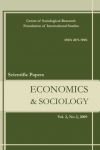SOCIAL AND ECONOMIC
DETERMINANTS OF QUALITY OF
LIFE: CASE OF EUROPEAN
COUNTRIES
SOCIAL AND ECONOMIC
DETERMINANTS OF QUALITY OF
LIFE: CASE OF EUROPEAN
COUNTRIES
Author(s): Tetyana Vasylieva, Wioleta Witczak-Smolnik, Inna Tiutiunyk, Bálint FilepSubject(s): Social development, EU-Approach / EU-Accession / EU-Development, Socio-Economic Research
Published by: Fundacja Centrum Badań Socjologicznych
Keywords: quality of life; government expenditure; education; health care; physical culture and sports;
Summary/Abstract: The article is devoted to the study of economicand social drivers of quality of life. The method ofweighted sums and the Fishburn formula were employedto assess the level of quality of life. Using Ward's methodand the Kalinsky-Kharabash test, three clusters ofcountries were identified. The relationship betweenindicators was modeled with the Johansen, Dickey-Fullerand Phillips-Perron tests. Five indicators of socialdevelopment (children out of school, unemployment,literacy rate, hospital beds, total population) and sixindicators of economic development (GDP, minimumwage, government expenditure on education, currenthealth expenditure, state expenditure on physical cultureand sports industry) were chosen to establish therelationship between the indicators. The research wasfocused on the data of 30 European countries. Twohypotheses were proposed and tested in the study.Hypothesis H1 was that public spending on education,health care, and sports stimulates an increase in the qualityof life. This hypothesis was confirmed for all countries.Hypothesis H2 assumed that the number of children outof school, the level of unemployment, and illiteracynegatively affect the quality of life. This hypothesis wasconfirmed only for a small number of countries.
Journal: Economics and Sociology
- Issue Year: 16/2023
- Issue No: 4
- Page Range: 289-308
- Page Count: 20
- Language: English

